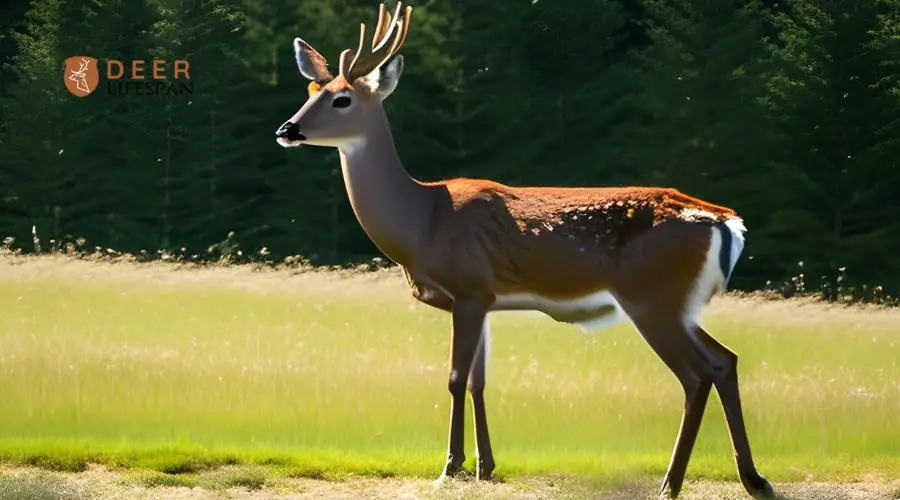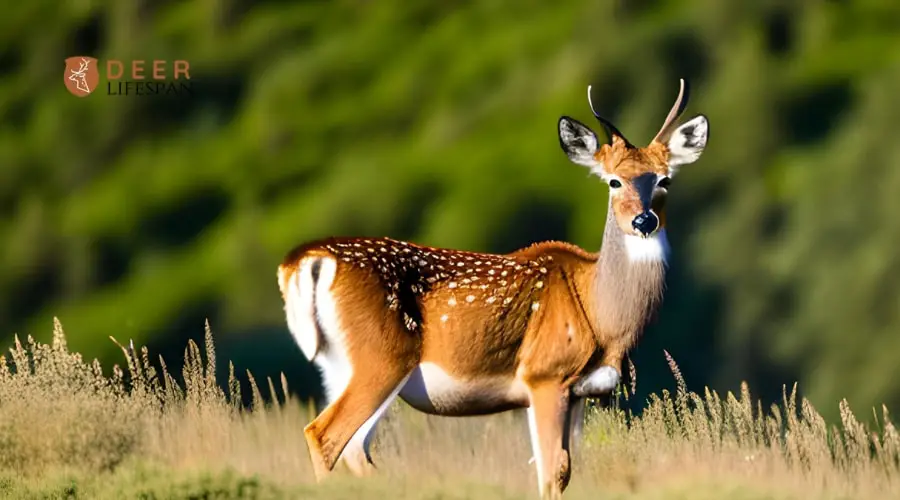The white tail of deer is an intriguing and essential characteristic that has long captivated wildlife enthusiasts and biologists alike. This distinct feature holds a deeper purpose than mere aesthetics.
Understanding why deer have white tails sheds light on their survival strategies and behaviour. In this exploration, we delve into the evolutionary significance of the white bottom and its role in communication, camouflage, and predator evasion.
By uncovering the mysteries behind this striking adaptation, we gain valuable insights into the fascinating world of deer. And their remarkable ability to thrive in diverse environments.

Table of Contents
Why Do Deer Have White Tails?
Deer have white tails for several evolutionary and survival-related reasons. The whitetail serves as a warning signal and communication, helping them survive in their natural habitats.
Here are some key reasons why deer have white tails:
Predation Avoidance
Deer are prey animals; their white tails defend against predators. When startled or threatened, a deer will raise its tail to expose the white underside.
The sudden display of a large, bright white patch catches the attention of predators, redirecting their focus away from the deer’s body. This behaviour, known as “flagging,” is intended to confuse or distract predators, giving the deer a chance to escape.
Group Communication
They are social animals and often live in herds. The whitetail also serves as a communication tool among individuals in the group.
When one deer detects danger or perceives a threat, it may lift its tail to signal others nearby. And it indicates that they should be vigilant or flee. This helps to coordinate group responses and enhances the overall safety of the herd.
Camouflage Effectiveness
Surprisingly, the whitetail can also aid in camouflage. When a deer is resting or bedded down, it often tucks its tail over its back.
The white colouration blends with the surroundings in specific snowy or frosty environments. It makes it more challenging for predators to spot the deer when inactive.
Distraction Technique
The sudden, conspicuous display of the whitetail might divert a predator’s attention. And encourage it to focus on the bottom rather than the deer’s body. This split-second distraction can be enough for the deer to escape into cover or run to safety.
Do All Deers Have White Tails?
No, not all deer have white tails. The white-tailed deer gets its name from the distinctive white colour on the underside of its tail. And it is raised when the deer is alarmed or running. However, this trait is specific to white-tailed deer (Odocoileus virginianus); not all deer species share this characteristic.
Different deer species have various tail colours and markings. For example, mule deer (Odocoileus hemionus) typically have a white rump patch with a black-tipped tail. At the same time, the bottom of the black-tailed deer (Odocoileus hemionus columbianus) is darker and lacks a distinct white underside.

Do All Deer Flag With Their Tails?
No, not all deer flag with their tails. “Flagging” is observed in some deer species, particularly white-tailed deer (Odocoileus virginianus). When a white-tailed deer senses danger or becomes alarmed, it may raise its tail.
And display the white underside as a warning signal to other deer in the area. This action is often referred to as “flagging.”
However, not all deer species exhibit this specific tail-flagging behaviour. Different deer species may have unique behaviours to communicate with each other and respond to threats or perceived danger.
For instance, mule deer (Odocoileus hemionus) are another common deer species, and while they share some similarities with white-tailed deer, they may have different behaviours in response to threats.
In summary, tail-flagging is specific to certain deer species, like white-tailed deer, and may not be seen in all deer species.
Do Deer Communicate With Their Tails?
Yes, deer communicate with their tails as part of their body language. Like other animals, deer use their seats to convey information and emotions to others in their herd or potential environmental threats.
Here are some of the ways deer use their tails for communication:
Alarm
When deer sense danger or perceive a potential threat nearby, they raise their tails, displaying a white underside, which acts as a visual warning signal to other nearby deer.
This behaviour alerts other herd members to be cautious and aware of potential danger.
Alertness
A deer may flick its tail rapidly or twitch it when alert but not necessarily alarmed. This indicates that the deer is paying attention to its surroundings and might be preparing to take evasive action if necessary.
Submissive behaviour
Lowering the tail and tucking it between the hind legs signifies submission or fear. When a subordinate deer approaches a dominant one, it may display this behaviour to avoid conflict or aggression.
Aggression
Occasionally, deer may display aggressive behaviour, particularly during mating season or when establishing dominance. An aggressive deer may raise its tail and flare it out, signalling its readiness to defend its territory or challenge another deer.
Relaxation
A deer feeling calm and at ease usually keeps its tail in a neutral position, hanging loosely without any particular tension.
Communication with Fawns
Mother deer use their tails to communicate with their fawns. They may raise their seats to signal the fawns to follow or lower their hearts. This is done to encourage the fawns to stay hidden and still.
While tail movements play a significant role in deer communication, they rely on other body language signals. Vocalizations and scent marking to convey information effectively within their social and ecological contexts.
What Do Whitetail Deer EAT?
FAQs
Are there any specific tail movements that indicate different emotions in deer?
Yes, deer exhibit distinct tail movements to express various emotions. For instance, rapid twitching or tail flicking often indicates agitation or nervousness. At the same time, a lowered tail may signal submission to a more dominant individual.
Do fawns also exhibit tail-flagging behaviour, or is it exclusive to adult deer?
Tail-flagging is not exclusive to adult deer. From a very young age, even fawns may raise their tails when alarmed, imitating the behaviour they observe in adult deer.
Are there other animals in the animal kingdom that use tail communication similar to deer?
Yes, tail communication is not unique to deer. Various other animals, such as canines, primates, and birds, also use their tails to convey emotions, intentions, or warning signals to their peers.
How far away can other deer see the white tail flagging of their peers?
The visibility of tail-flagging can vary depending on lighting conditions and terrain. Generally, deer within a few hundred yards can see the white flag, allowing for effective communication within the group.
Can deer distinguish between human-made dangers and natural predators through tail-flagging?
Deer have evolved to respond to various threats, including natural predators and human presence. While the exact distinction may not be apparent, tail-flagging is a warning signal for potential danger.
Conclusion
In conclusion, the white tails of deer are a vital survival adaptation and communication tool. Through their stunning display of tail-flagging and various tail movements, deer effectively warn each other of danger and maintain social cohesion.
Understanding and appreciating these fascinating traits deepen our admiration for these graceful creatures. And underscore the importance of preserving their habitats for future generations to enjoy.

